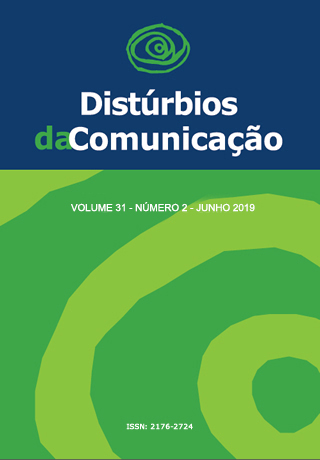Prevalência de penetração e/ou aspiração laringotraqueal na Doença de Parkinson em centro especializado de reabilitação
DOI:
https://doi.org/10.23925/2176-2724.2019v31i2p255-260Palavras-chave:
Deglutição, Transtornos de Deglutição, Doença de Parkinson, Prevalência, Pneumonia AspirativaResumo
Introdução: Penetração e/ou aspiração laringotraqueal (PA) são achados clínicos que constituem importante parâmetro na mensuração do risco para a segurança da deglutição devido às possíveis complicações pulmonares. Objetivo: Identificar a prevalência de penetração e/ou aspiração na Doença de Parkinson (DP) em Centro Especializado de Reabilitação (CER). Método: Estudo clínico observacional retrospectivo. Foram analisados 39 laudos de exames de videoendoscopia da deglutição realizadas em Centro Especializado de Reabilitação “Universidade Estadual Paulista-UNESP/Marília”, no período de 2006 a 2016. Dos 39 (100%) indivíduos, 19 (48,71%) eram do gênero feminino e 20 (51,28%) do gênero masculino, com idade que variou de 43 a 85 anos (média de idade de 71 anos) e somente 29 (74,35%) desses indivíduos apresentavam classificação de Hoehn & Yahr (1967) variando de um a cinco. Realizada análise da PA nas consistências pastosa, líquida espessada e líquida e com volume que variou de 5 a 10 ml segundo a definição proposta por Rosenbek et al, 1996. Para análise estatística foi utilizado o Teste de Fisher. Resultados: Constatou-se que 28 (71,79%) indivíduos não apresentaram penetração e/ou aspiração laringotraqueal e 11 (28,21%) apresentaram. Desses 11 (28,21%), quatro (10,25%) apresentaram penetração/aspiração na consistência pastosa (p=0,05), nove (23,07%) no líquido espessado (p=0,07) e nove (23,07%) no líquido ralo (p=0,02). Conclusão: Na população estudada nesse setting a ausência de PA foi mais frequente e a presença significante apenas no líquido ralo.
Downloads
Downloads
Publicado
Edição
Seção
Licença
Copyright (c) 2019 Renata Rodrigues Silva, Paula Cristina Cola, Suely Mayumi Motonaga, Evellyn Spazzapan, Beatriz Novais Merola, Roberta Gonçalves da Silva

Este trabalho está licenciado sob uma licença Creative Commons Attribution 4.0 International License.









